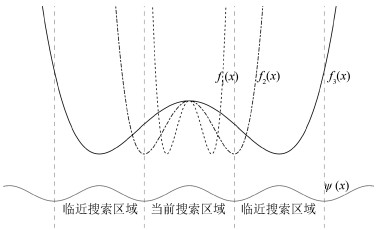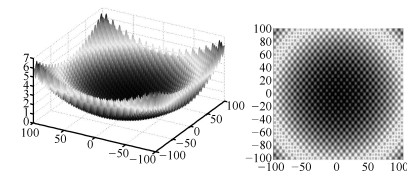-
摘要: 针对多峰优化问题, 本文结合多尺度量子谐振子算法的全局优化特性提出了基于划分的多尺度量子谐振子算法.对定义域进行合理均匀划分, 根据划分区域长度构建初始基态高斯曲线, 随着标准差衰减高斯曲线逐渐收敛, 从而在各个区域内快速搜索到极值点.对于实际函数的维度和极值数不同, 本文提出固定分辨率策略和多级分辨率策略来解决实际问题, 通过寻优精确性、全极值点寻优和全局多峰优化三个角度进行实验, 对比蚁群算法、差分进化算法等主流群智能算法, 可以表明该算法参数设置简单, 具有很好的寻优准确性、快速收敛性和记忆性.Abstract: To solve the problem of multimodal optimization, a partition-based multi-scale quantum harmonic oscillator algorithm (MQHOA) is proposed depending on MQHOA's global optimization characteristic. It divides reasonably a domain into uniform areas, and then Gauss curves with ground state can be constructed according to the lengths of these uniform areas. With the attenuation of standard deviation, the Gauss curves will converge gradually, thus, extreme points can be found quickly. In addition, two strategies comprising fixed wavelength resolution and muti-level resolution are used for practical problems. Experiments are carried out from three aspects including optimization's accuracy, all extremal points optimization and global multimodal optimization. Compared with the ant colony algorithm, differential evolution algorithms and other mainstream swarm intelligence algorithms, the algorithm has, in addition to its simpleness on setting parameters, superior optimization accuracy, fast convergence and memory property.
-
表 1 一维震荡函数两种策略寻优性能比较
Table 1 Comparison of two strategies for one dimensional shock function
K0 λ0 K1 CN1 TC1 K2 CN2 TC2 2 0.1 3.9 10 0.0030 4.0 4 0.0038 12 0.01 13.9 100 0.0180 11.9 10 0.0084 46 0.001 47.7 1 000 0.1499 41.6 31 0.0348 156 0.0001 157.0 10 000 1.312 144.2 100 0.167 500 0.00001 493.2 100 000 10.374 461.0 316 0.767 1592 0.000001 1515.0 1 000 000 95.614 1 419.6 1 000 3.067 表 2 二维Griewank函数两种策略寻优性能比较
Table 2 Comparison of two strategies for two dimensional Griewank function
K0 λ0 K1 CN1 TC1 K2 CN2 TC2 1 369 20 75.7 10 0.051 40.3 4 0.036 1 369 10 307.8 400 0.183 231.2 10 0.291 1 369 5 1 049.2 1 600 0.726 617.5 31 1.472 1 369 2 1 333.4 10 000 4.078 670.2 100 1.657 1 369 1 1 340.5 40 000 15.312 783.0 316 9.64 1 369 0.5 1 353.10 160 000 57.272 1 924.1 1 000 21.04 表 3 P-MQHOA与蚁群算法全极值搜索比较
Table 3 Comparison of total-extremum-searching of P-MQHOA and ant colony algorithm
NO. P-MQHOA
(x1, x2, f/(x1, x2))ANT 1 (-0.878093608, -0.878093599, 3.53255484) (-0.8781, -0.8781, 3.5326) 2 (-0.878093550, -0.526852857, 3.042136418) -0.8737, -0.5310, 3.0362 3 (-0.878093617, -0.17561706, 2.796928371) (-0.8725, -0.1810, 2.7873) 4 (-0.878093568, 0.175617049, 2.796928371) (-0.8725, -0.5310, 3.0362) 5 (-0.878093628, 0.526852825, 3.042136418) (-0.8700, 0.5175, 3.0176) 6 (-0.878093611, 0.878093569, 3.53255484) (-0.8675, 0.8675, 3.4966) 7 (-0.52685281, -0.878093573, 3.042136418) (-0.5310, -0.8737, 3.0362) 8 (-0.526852791, -0.526852812, 2.551717996) (-0.5268, -0.5268, 2.5517) 9 (-0.526852794, -0.175617069, 2.306509949) (-0.5352, -0.1773, 2.3056) 10 (-0.526852803, 0.17561705, 2.306509949) (-0.5215, 0.1700, 2.2969) 11 (-0.526852866, 0.526852858, 2.551717996) (-0.5200, 0.5200, 2.5367) 12 (-0.526852827, 0.878093628, 3.042136418) (-0.5175, 0.8700, 3.0176) 13 (-0.175617027, -0.878093592, 2.796928371) (-0.1810, -0.8725, 2.7873) 14 (-0.175617075, -0.526852805, 2.306509949) (-0.1773, -0.5252, 2.3056) 15 (-0.175617028, -0.175617046, 2.061301903) (-0.1756, -0.1756, 2.0613) 16 (-0.175617006, 0.175617028, 2.061301903) (-0.1756, 0.1756, 2.0559) 17 (-0.175617067, 0.526852847, 2.306509949) (-0.1700, 0.5215, 2.2969) 18 (-0.175617056, 0.878093620, 2.796928371) (-0.1675, 0.8700, 2.7759) 19 (0.175617041, -0.878093592, 2.796928371) (0.1675, -0.8700, 2.7759) 20 (0.175617068, -0.526852815, 2.306509949) (0.1700, -0.5215, 2.2969) 21 (0.175617061, -0.175617041, 2.061301903) (0.1715, -0.1715, 2.0559) 22 (0.175617051, 0.175617057, 2.061301903) (0.1756, 0.1756, 2.0613) 23 (0.175617054, 0.526852783, 2.306509949) (0.1773, 0.5252, 2.3056) 24 (0.175617039, 0.878093590, 2.796928371) (0.1810, 0.8725, 2.7873) 25 (0.526852762, -0.878093542, 3.042136418) (0.5175, -0.8700, 3.0176) 26 (0.526852876, -0.526852885, 2.551717996) (0.5200, -0.5200, 2.5367) 27 (0.526852785, -0.175617064, 2.306509949) (0.5215, -0.1700, 2.2969) 28 (0.526852823, 0.175617064, 2.306509949) (0.5252, 0.1773, 2.3056) 29 (0.52685278, 0.52685282, 2.551717996) (0.5268, 0.5268, 2.5517) 30 (0.526852781, 0.878093598, 3.042136418) (0.5310, 0.8737, 3.0362) 31 (0.878093552, -0.878093598, 3.53255484) (0.8675, -0.8675, 3.4966) 32 (0.87809359, -0.526852814, 3.042136418) (0.8700, -0.5175, 3.0176) 33 (0.878093528, -0.175617038, 2.796928371) (0.8700, -0.1675, 2.7759) 34 (0.878093604, 0.175617041, 2.796928371) (0.8725, 0.1810, 2.7873) 35 (0.878093617, 0.526852807, 3.042136418) (0.8737, 0.5310, 3.0362) 36 (0.878093597, 0.878093581, 3.53255484) (0.8781, 0.8781, 3.5326) 表 4 二维Griewank函数极值分布拟合结果
Table 4 Fitting results of extremum values0 distribution of Griewank function
Func. No. ε P-MQHOA MOBi-DE CDE SDE S-CMA CMA SPSO PER-PSO r2pso r3pso Niching-based BNPGA
NSGA-Ⅱf1 1 0.05 1(4) 1(4) 1(4) 1(4) 1(4) 1(4) 0.44(12) 0.82(10) 0.76(11) 0.84(9) 1(4) 1(4) f2 1 0.05 1(5) 1(5) 1(5) 1(5) 1(5) 1(5) 0.40(12) 1(5) 0.88(11) 0.96(10) 1(5) 1(5) f3 2 1E-6 2(2.5) 2(2.5) 2(2.5) 1.96(5) 1.92(7) 1.95(6) 1.38(9) 0.8(10) 0.48(12) 0.6(11) 2(2.5) 1.5(8) f4 5 1E-6 5(1.5) 5(1.5) 3.84(10) 4.70(6) 0.04(12) 0.6(11) 4.88(3) 4.84(4) 4.68(7) 4.74(5) 4.37(9) 4.64(8) f5 1 1E-6 1(6) 1(6) 0.72(12) 1(6) 1(6) 1(6) 1(6) 1(6) 1(6) 1(6) 1(6) 1(6) f6 5 1E-6 5(1.5) 5(1.5) 3.96(9) 4.6(7) 0(12) 0.64(11) 4.92(4) 4.96(3) 4.88(5) 4.72(6) 4.52(8) 3.56(10) f7 1 1E-6 1(5.5) 1(5.5) 0.8(11) 1(5.5) 1(5.5) 1(5.5) 1(5.5) 1(5.5) 1(5.5) 1(5.5) 0.6(12) 1(5.5) f8 4 5E-4 4(1.5) 4(1.5) 0.32(12) 3.72(4.5) 3.72(4.5) 3.43(7) 0.84(11) 3.68(6) 2.92(9) 2.76(10) 3.74(3) 3.34(8) f9 2 1E-6 2(3) 2(3) 0.04(12) 2(3) 1.6(7) 2(3) 0.08(11) 1.96(6) 1.44(9) 1.56(8) 2(3) 1.24(10) f10 1 1E-6 1(2) 1(2) 0.52(9) 0.32(10) 0.06(12) 0.18(11) 0.56(8) 1(2) 0.88(6) 0.76(7) 0.94(5) 0.96(4) f11 18 5 E-2 17.5(1) 17.4(2) 11.39(12) 12.78(9) 12.04(10) 12(11) 14.36(7) 15.61(6) 15.95(5) 16.45(4) 16.94(3) 13.72(8) f12 6 0.05 6(1.5) 6(1.5) 5.56(6.5) 4.88(12) 5.56(6.5) 5.81(3) 5.6(5) 5.28(10) 5.52(8) 5.16(11) 5.36(9) 5.71(4) f13 36 1E-3 35.6(1) 35.4(2) 33.8(3) 23.8(7) 24.6(6) 23.6(8) 25.72(5) 21.8(12) 22.4(9) 22.2(10) 22.05(11) 31.76(4) f14 218 1E-3 163.56(2) 175.88(1) 152(3) 50.6(8) 0.6(12) 32.5(11) 70.12(6) 68.6(7) 40.6(10) 45.4(9) 92.76(5) 121.54(4) Total ranks 38 39 111 92 109.5 102.5 104.5 92.5 113.5 111.5 85.5 88.5 表 5 P-MQHOA算法与MOBi-DE算法时间消耗 (s)
Table 5 Time consumption of P-MQHOA algorithm and MOBi-DE algorithm (s)
Func. f1 f2 f3 f4 f5 f6 f7 f8 f9 f10 f11 f12 f13 f14 P-MQHOA 0.01 0.01 0.01 0.01 0.01 0.01 0.02 0.1 0.1 0.1 1.76 0.28 4.32 12.14 MOBi-DE 1.56 1.46 2.82 2.64 1.54 2.04 1.68 18.34 15.28 41.24 46.28 36.49 51.74 72.36 -
[1] Chang Y W, Yu G F. Multi-Sub-Swarm PSO algorithm for multimodal function optimization. In:Proceedings of the 2014 International Conference on Computer Science and Information Technology. India:Springer, 2014. 687-695 [2] Qu B Y, Suganthan P N, Das S. A distance-based locally informed particle swarm model for multimodal optimization. IEEE Transactions on Evolutionary Computation, 2013, 17(3):387-402 doi: 10.1109/TEVC.2012.2203138 [3] Shih C J, Teng T L, Chen S K. A niche-related particle swarm meta-heuristic algorithm for multimodal optimization. In:Proceedings of the 2nd International Conference on Intelligent Technologies and Engineering Systems. Switzerland, Germany:Springer, 2014. 313-321 [4] Agrawal S, Sanjay S. FRPSO:fletcher-reeves based particle swarm optimization for multimodal function optimization. Soft Computing, 2014, 18(11):2227-2243 doi: 10.1007/s00500-013-1196-2 [5] Qu B Y, Suganthan P N, Liang J J. Differential evolution with neighborhood mutation for multimodal optimization. IEEE Transactions on Evolutionary Computation, 2012, 16(5):601-614 doi: 10.1109/TEVC.2011.2161873 [6] Basak A, Das S, Tan K C. Multimodal optimization using a biobjective differential evolution algorithm enhanced with mean distance-based selection. IEEE Transactions on Evolutionary Computation, 2013, 17(5):666-685 doi: 10.1109/TEVC.2012.2231685 [7] Pang C Y, Li X, Liu H, Wang Y F, Hu B Q. Applying ant colony optimization to search all extreme points of function. In:Proceedings of the 5th IEEE Conference on Industrial Electronics and Applications. Taichung, China:IEEE, 2010. 1517-1521 [8] Dasgupta B, Divya K, Mehta V K, Deb K. RePAMO:recursive perturbation approach for multimodal optimization. Engineering Optimization, 2013, 45(9):1073-1090 doi: 10.1080/0305215X.2012.725050 [9] Vidya R C, Phaneendra H D, Shivakumar M S. Quantum algorithms and hard problems. In:Proceedings of 5th IEEE International Conference on Cognitive Informatics. Washington, DC, USA:IEEE, 2006. 783-787 [10] 王鹏.云计算的关键技术与应用实例.北京:人民邮电出版社, 2010. 168-194Wang Peng. The Key Technology and Application Examples of Cloud Computing. Beijing:People's Posts and Telecommunications Press, 2010. 168-194 [11] 王鹏, 黄焱, 任超, 郭又铭.多尺度量子谐振子高维函数全局优化算法.电子学报, 2013, 41(12):2468-2473 http://www.cnki.com.cn/Article/CJFDTOTAL-DZXU201312023.htmWang Peng, Huang Yan, Ren Chao, Guo You-Ming. Multi-Scale quantum harmonic oscillator for high-dimensional function global optimization algorithm. Acta Electronica Sinica, 2013, 41(12):2468-2473 http://www.cnki.com.cn/Article/CJFDTOTAL-DZXU201312023.htm [12] 王鹏, 黄焱.多尺度量子谐振子优化算法物理模型.计算机科学与探索, 2015, 9(10):1271-1280 http://www.cnki.com.cn/Article/CJFDTOTAL-KXTS201510014.htmWang Peng, Huang Yan. Physical model of multi-scale quantum harmonic oscillator optimization algorithm. Journal of Frontiers of Computer Science and Technology, 2015, 9(10):1271-1280 http://www.cnki.com.cn/Article/CJFDTOTAL-KXTS201510014.htm [13] 肖黎彬, 王鹏, 陈磊, 郭又铭.量子谐振子优化算法.计算机应用, 2013, 32(S2):1-4, 44 http://www.cnki.com.cn/Article/CJFDTOTAL-JSJY2012S2000.htmXiao Li-Bin, Wang Peng, Chen Lei, Guo You-Ming. Quantum harmonic oscillator optimization algorithm. Journal of Computer Applications, 2013, 32(S2):1-4, 44 http://www.cnki.com.cn/Article/CJFDTOTAL-JSJY2012S2000.htm [14] Mallat S G. A theory for multiresolution signal decomposition:the wavelet representation. IEEE Transactions on Pattern Analysis and Machine Intelligence, 1989, 11(7):674-693 doi: 10.1109/34.192463 [15] 左斌, 胡云安, 施建洪.极值搜索算法的研究与进展.海军航空工程学院学报, 2006, 21(6):611-617 http://www.cnki.com.cn/Article/CJFDTOTAL-HJHK200606003.htmZuo Bin, Hu Yun-An, Shi Jian-Hong. Research and development of extremum seeking algorithm. Journal of Naval Aeronautical Engineering Institute, 2006, 21(6):611-617 http://www.cnki.com.cn/Article/CJFDTOTAL-HJHK200606003.htm -






 下载:
下载:








